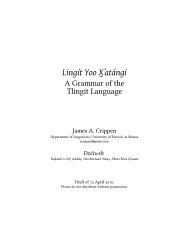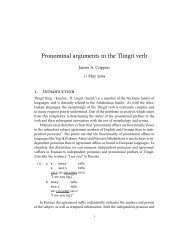A comparison of morphosyntactic features between Marquesan ...
A comparison of morphosyntactic features between Marquesan ...
A comparison of morphosyntactic features between Marquesan ...
You also want an ePaper? Increase the reach of your titles
YUMPU automatically turns print PDFs into web optimized ePapers that Google loves.
(12) a. ‘ua fārerei au i teie nau poti‘i i Farani<br />
PERF meet 1SG.S DO these PC girl LOC France<br />
“I met these (few) girls in France” (Lazard & Peltzer 2000:167) TAH<br />
b. ‘ua hālawai au i kēia wahi pōki‘i i Palani<br />
PERF meet 1SG.S DO these PC younger.cousin LOC France<br />
“I met these (few) younger cousins in France” HAW<br />
In <strong>comparison</strong>, Tryon (1970:11) describes nau as an article that indicates proximal<br />
plurality, similar to English “these”. He contrasts this with tau na which he<br />
says indicates distal plurality, similar to English “those”. As both are categorized<br />
with na<br />
(13) a. a hi‘o na ‘i tēra nau tia‘a<br />
IMP look hither DO those PL.PROX shoe<br />
“look at these shoes” (Tryon 1970:11)<br />
b. tau na tumu ‘anani<br />
PL.DIST tree orange<br />
“the orange trees” (id.)<br />
TAH<br />
TAH<br />
e use <strong>of</strong> tēra is confusing in example 13a because it is the distal demonstrative<br />
indicating distance from both speaker and listener. is contrasts with the stated<br />
meaning <strong>of</strong> nau which is supposed to be a proximal article. Probably tēra is a typo<br />
for tēia which is the proximal demonstrative.<br />
Tryon (1970:12) gives a “series <strong>of</strong> words indicating a group” in TAH: hui “group<br />
<strong>of</strong> esteemed people”, mā “family group”, nana “flock or herd”, taura “race or breed”,<br />
ruru “tied bundle”, ‘amui “tied bundle <strong>of</strong> identical goods”, ‘atā = ruru, pe‘etā “bunch<br />
attached to a branch”, atari “bunch picked from a tree”, pupā “bunch <strong>of</strong> small fruits”,<br />
pu‘e “collection <strong>of</strong> men, animals, or food”, feiā “group <strong>of</strong> people engaged in activity”,<br />
and ma‘a “small quantity <strong>of</strong> food or drink”.<br />
4. CONCLUSION<br />
Several tentative conclusions are available from the data presented here. One is that<br />
the categories <strong>of</strong> “definite” versus “indefinite” are rather indistinct in all <strong>of</strong> these<br />
languages, as seen in table 1, and should be carefully revisited with new elicitation<br />
8





